Entries in safari (118)
Day 8 - Savuti Camp, Linyanti Concession, Botswana
 Monday, August 2, 2010 at 11:04AM
Monday, August 2, 2010 at 11:04AM Up at 5:30 again, a light breakfast out on the deck at 6, and we were off by 6:20. It is amazing how different people behave after a cup of coffee, and I am speaking of me as well as the other people in the group. Smiles happen only after that first sip of caffeine.
We pointed the vehicles towards Dish Pan and Rock Pan, and immediately started tracking a pack of wild dogs. Woohoo! My vehicle was a little farther away, and I could hear the other 2 vehicles and their excitement over the airwaves. “matala mathlarelaa matala mathlarelaa”, and I knew they were on to something good.
There are three dog packs near Savuti, and this was the smallest of the three with only 4 adults. When we had our sighting I noticed that there were only 3 of the 4: 2 males and a female. We were lucky in that we saw them right on the Savuti channel, which is much preferred over the thick mopane woodland. They were out in the open, and after a few minutes they started out on their morning hunt. We were able to stick with them, as they never left the water’s edge. What a treat, as wild dogs can be some of the most challenging subjects to photograph.
We gave them room to work, and eventually we saw some impala about 200 meters away. Double cha-ching. The lead dog quickly went into a crouched position, and he had the advantage as he was downwind and the impala had not noticed the pack. After a few moments a chase ensued, and our three vehicles burst into action from behind. The pack split up and we followed one of the males back towards the water. We had hoped that one of the impala went that direction, as we would have the dogs back in the open and would hopefully see a kill at the same time. Well, the strategy paid off and we watched the 2 males chase a lone impala across the channel and onto a swampy island in the middle of the water. The kill happened so fast that nobody was able to see it as we were moving the vehicle just to keep up. So many great things to photograph: wild dogs crossing deep water, a kill, a tawny eagle going in after they were finished, the female dog trying to get to the island, and then finally the dogs’ coming back across the water towards us.
It has been a while since I have filled up a memory card in less than an hour, and this morning I suspect it too much less time than that.
On the afternoon game drive, we took a slow approach to try and fill in our safari with all of the other things that we had not spent enough time working on, like birds, buffalo, landscapes and general plains game. We split off from the other 2 vehicles and decided to spend some time with a rather lively family of elephants, who were down at the channel drinking water. Kane noticed some interesting behavior on the edge of these large pachyderms, and we noticed that one large bull was trying to keep a smaller bull away from one of the females in estrus. The smaller male was approaching the female, and she wasn’t interested in mating with him, despite his ‘5th leg’, which was ready to go into action. The female ran away, and the smaller bull raced after her through the shallow water’s edge. Trailing behind was the larger bull, and the trumpeting and splashing of water was quite amazing to see. These types of events always make me realize that life in the wild is all about sex, violence, eating and sleeping.
After some time spent with this threesome, we continued driving down the channel to the west, and we tracked down the Savuti pride of lions, which includes an adult female and her two sub-adult males. The males are under 2 years of age, however they are already larger than her mother. We initially saw only the 2 males, and after 15 minutes we heard the mother’s quiet roars in the distance. We repositioned the vehicles to witness their reunification, and you can see just how close of a bond the family has.
After a few minutes of loving behavior, they moved towards the channel and positioned themselves to watch over herbivores on the opposite side of the water. These lions are quite smart, in that they had positioned themselves at the end of the backflow, and any animal that wanted on the other side of the channel would have to come face to face with them.
We headed back to camp after sunset, and all talked about what an amazing day it was. After a quick shower, Sean the manager and I heard over the radio that the Duma Tau male leopard was set to walk through camp, and we ran to grab a vehicle to go out and see what was going on. It was already dark outside, and we saw his tracks but could not locate him in the thick bush. When we arrived back in camp, there were numerous camp staff using flashlights along the walkway. Apparently he had walked right through camp and had found his way back out of camp. At dinner we all had good laughs and smiles, and myself, Grant and James asked each person to tell the group what their favorite moment, memory or photograph from the trip was. I love doing this exercise, as it collectively reminds everybody that we all see and feel different things while out on safari. These kinds of moments help remind me just how much I love my job and career, and how I am doing what I was meant to do with my life. My old software consulting career was less than fulfilling, and I have found something that I am extremely passionate about.
Note: All images in these daily blog postings are very very rough edits of the things we have seen, and I often omit the photographs that take too much time to process. I don’t take much time off during the day, as I am working with people with their photographic needs. All of my images in these posts will have to be re-processed when I get back home, and they are only included in these blog entries for illustration purposes.
Day 6 –Savuti Camp, Linyanti Concession, Botswana
 Friday, July 30, 2010 at 11:55AM
Friday, July 30, 2010 at 11:55AM Today we had yet another overcast day, and it never really got cold at all. Perhaps the mid 50’s isn’t cold for wintertime, and I am sure future days will get cold again. We drove to the open woodland, along the Linyanti River, and we saw herds of giraffe, elephants feeding on the tall grass, baboons and a few wildebeest. We heard some commotion and saw some hyaenas feeding on a day-old giraffe carcass. After 30 minutes, two lionesses came back and wanted to reclaim their kill and the hyaenas quietly walked away. I suspect there was so much meat on the kill that there was enough to go around without too much displacement.
One of the female lions was quite pregnant and should have cubs soon, and the other female had a ‘milky eye’ and was a bit more aggressive. We watched them do the typical dining activities, and we broke off after a little while to go have some coffee and tea. Kills are always a great thing to see, especially for the first time, however it doesn’t always produce the types of photographs that people anticipate.
After lunch we worked with the local wild dog researcher to locate and photograph a pack of wild dogs. Wild dog sightings are rare to begin with, and this one was special because they also had 5 puppies with them. The pack was 17 strong, and we just sat and watched them sleep and play for the afternoon. What a treat. The dogs had a temporary den that they will keep for only a few days, and we worked with the researcher to locate the pack using a radio collar, and it took a fairly decent offroad drive over mopane trees to get there. This sighting was definitely a challenge photographically, because we never did get a good, open area where they were playing.
On the way back to camp, we sat and watched a large herd of elephants cross the road in absolutely perfect light. What a day!
Note: All images in these daily blog postings are very very rough edits of the things we have seen, and I often omit the photographs that take too much time to process. I don’t take much time off during the day, as I am working with people with their photographic needs. All of my images in these posts will have to be re-processed when I get back home, and they are only included in these blog entries for illustration purposes.
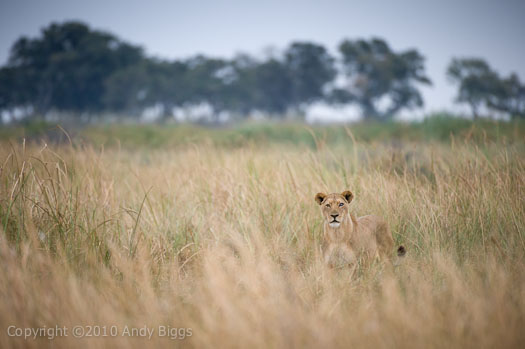
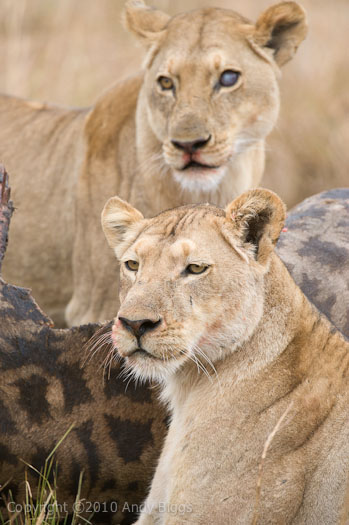
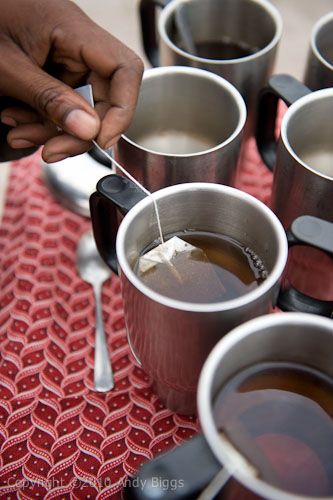
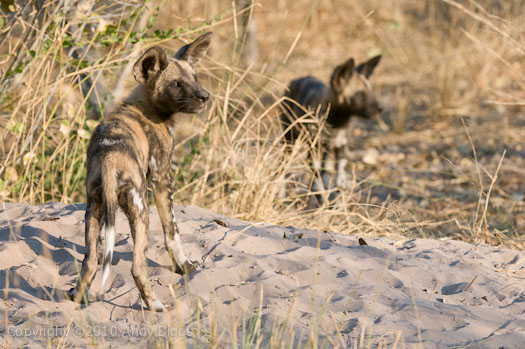
 Botswana,
Botswana,  Savuti,
Savuti,  okavango,
okavango,  safari in
safari in  Safari Reports
Safari Reports Day 5 –Chitabe Camp / Savuti Camp, Botswana
 Thursday, July 29, 2010 at 07:39AM
Thursday, July 29, 2010 at 07:39AM Today was our last day at Chitabe Camp, and like the previous mornings, it wasn’t too cold when we started out. It was overcast and more windy today than the past few days. On the days when we are leaving one camp and heading to another, we typically have a shorter morning game drive to allow for an early brunch, packing of duffle bags and time to get to the airstrip.
We knew we wouldn’t be out for more than about 3 hours, so we chose to search for game closer to camp. We found a healthy-sized cape buffalo herd, and chose to spend the bulk of our time with them. When photographing buffalo, if you wait for a long while you may end up with them on all sides of your vehicle. We didn’t have the time to accomplish that particular approach this morning, due to time constraints. We were able to find quite a few red billed oxpeckers on their backs and faces, and chose to home in on the symbiotic relationship between the two.
After a nice brunch, the Chitabe staff sent us on our way with smiles and full bellies. We made it to the airstrip before our pilots arrived, and we took the time to tell bush stories and just chew the fat. On all of my safaris, we always provide whatever it takes to allow people to bring enough camera gear to make the safari successful. On this safari we have provided for a pair of Cessna Caravans for our group, which significantly increased the weight allowance from only 44 pounds to more than double. This is a huge benefit if photography is your main goal from your safari.
After only a 30 minute flight to Savuti, we disembarked our planes and jumped into our safari vehicles. I also had a chance to see my friend and guide Kane, which is an excellent safari photographer and guide. You can see his photographs at www.kanethebushman.com. I helped him setup his web site last year, and he updates his site often.
After a 3:00 tea, we headed out for our first game drive at Savuti. Right outside of camp, we were stopped by a large group of elephants on both sides of the road. A lone bull elephant decided to walk towards us and dined on a healthy diet of minerals about 10 feet from us. We had a great time zooming in and grabbing intimate details of his face, ears and tusks, and when he was through putting on a show for us, he picked up some loose dirt and flung it in our faces. I actually had to turn my D700 + 70-200mm lens upside down just to get the dirt out. Talk about a fun time with a very very relaxed bull elephant that all in the vehicle will remember.
As the sun started to get low in the sky, we worked the edges of the Savuti channel in hopes of picking up lion or leopard tracks. We did track a lion for the better part of 2 hours, however we never could catch up with it before we had to head back to camp.
On the way back to camp, we stopped to photograph a lone bull elephant crossing the channel. The channel is more flooded now than in recent years, and the water is flowing all the way to the Savuti marsh, inside Chobe National Park. This is a significant change since the early 1980’s, as the channel hasn’t held flowing water since that time. The area is lush and green, and elephants are crossing the water quite often.
We were back to camp on the early side, as we didn’t stop for anything on the way back. An early dinner awaited, and now I cannot wait for tomorrow’s game drives, as we have heard of the local wild dog pack’s movements near our camp.
Note: All images in these daily blog postings are very very rough edits of the things we have seen, and I often omit the photographs that take too much time to process. I don’t take much time off during the day, as I am working with people with their photographic needs. All of my images in these posts will have to be re-processed when I get back home, and they are only included in these blog entries for illustration purposes.

James Weis strutting his photographic stuff with BB, our guide
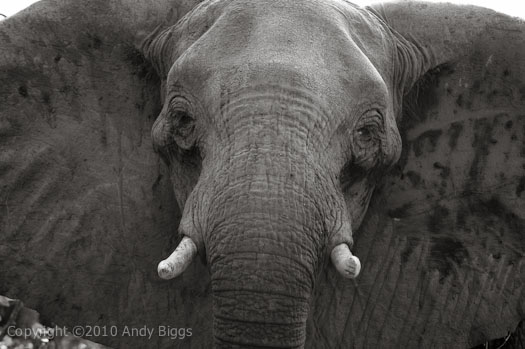

Lone elephant, crossing the Savuti channel at sunset
Day 3 –Chitabe Camp, Okavango Delta
 Tuesday, July 27, 2010 at 07:47AM
Tuesday, July 27, 2010 at 07:47AM We had a photographically slow morning, however we did see some amazing wildlife. The morning started off with a civet, followed by a pair of honey badgers fairly close to the vehicle. General game followed, however the morning was more slower than normal. Perhaps the full moon kept all of the animals up all night and thus they were inactive and lying down for the morning. During the slow times I like to work on photographic techniques with people, and help introduce new approaches to wildlife photography. One of the first things I like to introduce are the benefits of using the rear autofocus button on cameras. Another is working on lighting and how to position the vehicle to take advantage of the light.
Back to camp near noon, then a nice brunch, and then some down time for everybody. We typically meet up at 3:30 for afternoon tea, and today was no exception. We left for our afternoon game drive at 4:00 and we were ready to get our shutters working hard after a slow morning.
Phinley tracked a lone female leopard just outside of camp, who has the nickname of ‘Karuru Female’. This was the same leopard that we photographed yesterday, and she was still calm in our presence. Positioning the vehicles turned out to be a bit challenging, as the ground was littered with dead tree limbs. It actually made for a great teaching opportunity in how we get clean backgrounds and how to photograph a leopards in a tree with backlighting. The last vehicle position for me yielded a fussy background, however I enjoyed having rim lighting on her chin and lower leg and paw (see image below).
We stopped for a sundowner drink on the way back to camp, and there were smiles and high fives all around after 3 successful leopard shoots in 2 days. It is always great to have great leopard sightings early on in a safari, as this is something that all travelers look forward to.
Note: All images in these daily blog postings are very very rough edits of the things we have seen, and I often omit the photographs that take too much time to process. I don’t take much time off during the day, as I am working with people with their photographic needs. All of my images in these posts will have to be re-processed when I get back home, and they are only included in these blog entries for illustration purposes.
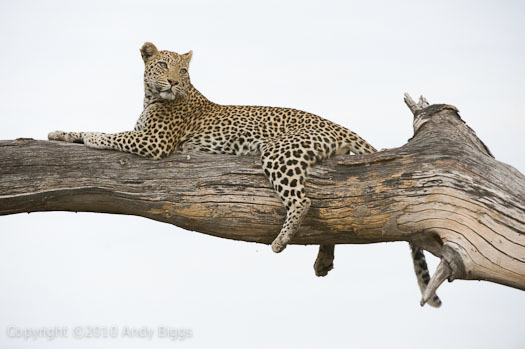
Nikon D700 + 200-400mm f/4 VR, 1/500 @ f/5.6, ISO 3200
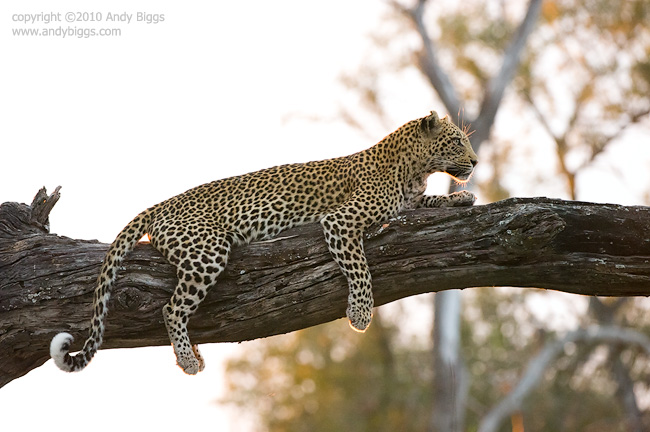
Nikon D700 + 200-400mm f/4 VR, 1/200 @ f/5.6, ISO 6400
Mahale Mountains National Park (Part 1 of 3)
 Monday, May 10, 2010 at 01:07PM
Monday, May 10, 2010 at 01:07PM Back in October of 2009, I led a safari to the remote region of Tanzania where the mountains meet the sea, where wild chimpanzees rule the jungle, and also where one company has managed to pull of an extraordinary experience for their guests. If you are interested in a very unique safari experience, read on. If you appreciate other peoples' wanderlust to locate remote places on the planet and come home with rich photographs and memories, you should also read on.
Background
I normally lead my photographic safaris to locations which are rich in mammals and birds, and these locations are almost always accessed with Land Rovers twice each day: a morning game drive and an afternoon game drive. The safari which I am about to describe began in this manner out on the open savannah of the Serengeti National Park, and after 6 days of that style of safari we traded in our diesel vehicles for other modes of transportation: long bush plane flights, boats on Lake Tanganyika and hiking with our feet.
Our destination was Mahale Mountains National Park, which lies on the eastern shore of Lake Tanganyika, Tanzania. Lake Tanganyika is estimated to be the second largest fresh water source on the planet, second only to Lake Baikal. The lake also borders the Democratic Republic of Congo, Burundi and Zambia. Mahale Mountains N.P. (now referred to just as Mahale in this blog entry) is a large sanctuary for wild chimpanzees, as well as many other animals and birds. Mahale is extremely remote and difficult to get to, and required us to fly on a private chartered Cessna Grand Caravan across Tanzania for half a day. We landed along the shore of Lake Tanganyika, and we were picked up by the staff of the camp where we were to stay for the next 3 nights, Greystoke Mahale.
Our boat was large and comfortable, and the camp staff greeted us with big smiles, cold drinks and a wonderful lunch. The boat ride took us from our airplane to our camp, about a 2 hour journey. The scene was very dramatic, as the mountains met the deep lake with only a small sliver of beach in the middle. As we enjoyed our cold beer, vagetable samosas and sandwiches, we imagined just how many wild chimpanzees were in the forest just off the lake's edge. Researches have some idea, however there is no easy way of doing a census due to the difficult terrain of the area.
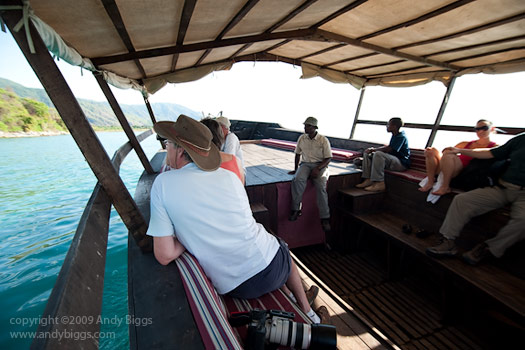
Our dhow for the next 3 days
After our relaxing 2-hour journey on the boat, we turned around a bend and all of a sudden we saw our luxurious camp out on the beach. It was like Robinson Crusoe meets civilization. Well, sort of. My idea of luxurious is likely very different than that of those who will only stay at a Ritz Carlton property, but this place was fantastic. I have a habit of taking over camps completely, and this is what we did with the Greystoke Mahale camp. We had full run of the place, and I am glad that we arranged it this way. The camp is set right on the lake's edge, and the main building is where all meals are served. All individual huts where we slept were slightly out of sight from the water, and were very very comfortable by any standards.
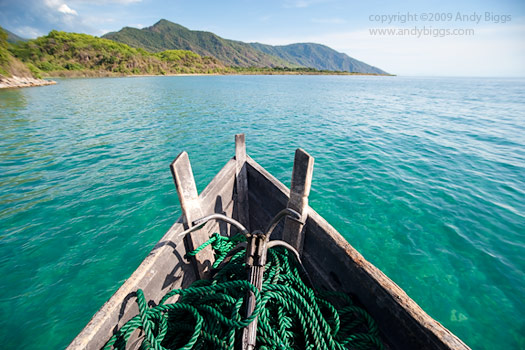
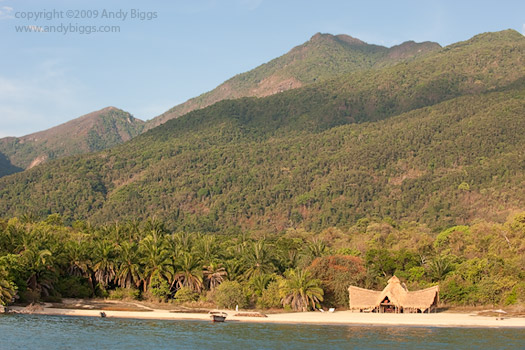
Greystoke Mahale, along the shores of Lake Tanganyika
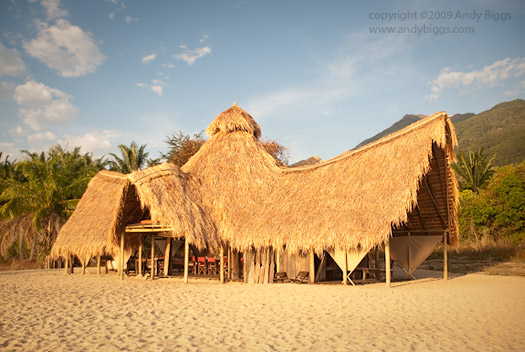
The dining hut, Greystoke Mahale
After our arrival on the beach, we were greeted by the camp staff who helped us off of the dhow. Grins from ear to ear, my guests settled into their huts for a quick afternoon nap. Some took a short hike in the forest, and others relaxed to watch the sun get low in the sky. The camp is on a small piece of land that happens to be level. Everything behind the camp is a steep and thick forested mountain. You can see the following image to fully appreciate what a hike in the mountains means. We would soon learn what that meant.
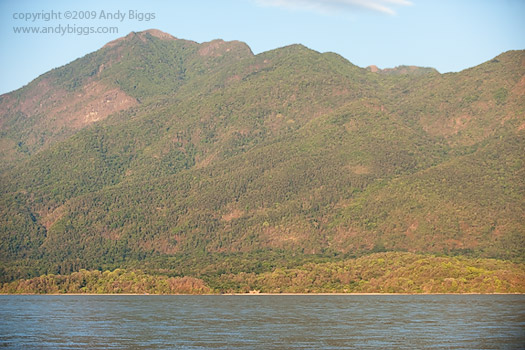
Mahale Mountains from Lake Tanganyika.
(notice Greystoke Mahale camp at the water's edge)
As the sun set we all gathered for drinks at the bar, and we talked about the long journey to get there. I thought about that one for a minute: If I left my home in the USA it would have taken me about 40 hours to reach there: car, plane, plane, car, car, bush plane, refuel, bush plane, dhow. The camp manager said that the closest road to us was easily 50 to 100 miles away, and I could certainly believe it.
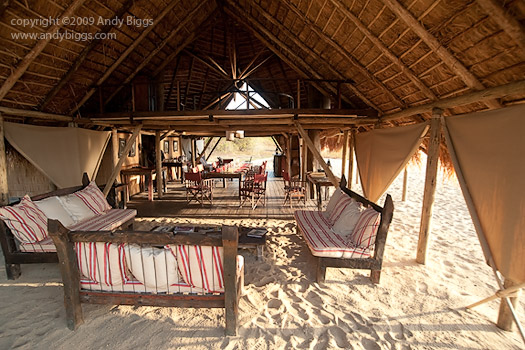
The common area of Greystoke Mahale
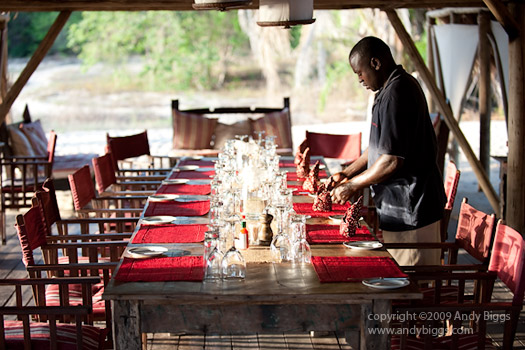
Getting ready for a meal in the dining hut
As we sipped our drinks, the sun set behind the mountains in the Democrative Republic of Congo in the distance. I thought to myself "why haven't I made it here before now". I didn't have an answer for that one, as I had always imagined photographing wild chimpanzees, but I never got around to planning the trip. I was looking forward to 3 nights at Greystoke, and was especially looking forward to photographing wild chimpanzees in their own environment.
 Chimpanzee,
Chimpanzee,  Greystoke,
Greystoke,  Mahale,
Mahale,  Tanganyika,
Tanganyika,  safari in
safari in  Safaris
Safaris Leopards and other predators of the Kruger
 Thursday, April 22, 2010 at 10:24AM
Thursday, April 22, 2010 at 10:24AM 
I am putting together a safari for this coming October in the Kruger area of South Africa, and it will be a small and intimate group. I am planning on only operating 2 Land Rovers, and we will split our time between two different camps in the Sabi Sands area, just west of Kruger National Park. The purpose of this safari will be to photograph leopards and lions up close and personal, as well as other general game in the area.
The Sabi Sands is one of the best destinations in Africa for leopard photographs, and I would like to hear from you if you have any measurable interest in such a trip. I have already mentioned this on my Facebook page, and I have enough interest to probably fill up the trip. Please email me at info@andybiggs.com to be placed on a notification list when I have more details.
 Kruger,
Kruger,  Sabi Sands,
Sabi Sands,  South Africa,
South Africa,  Workshop,
Workshop,  safari in
safari in  News,
News,  Safaris
Safaris Cheetah on the Serengeti Plains
 Thursday, April 1, 2010 at 03:40PM
Thursday, April 1, 2010 at 03:40PM 
Cheetah on the Serengeti Plains
Canon 5D Mark II, 600mm f/4, 1/800 @ f/4, ISO 50
Serengeti National Park, Tanzania. March 2010
As many readers of this blog may already know, 1) I don't shoot with Canon gear any longer, and 2) didn't even take a digital camera with me to Tanzania last month. So let me explain the image above. We were out on a morning game drive, and we came across this cheetah mother on the open plains. One of my generous travelers, Ben, quickly loaned me his 600mm lens on a 5D Mark II camera body, as he had a great opportunity to photograph the above female as she was moving her week-old cubs by her mouth. The 600mm was waaaaaaay too much lens for this, as she was passing only a few meters in front of our vehicle. The 'real' shot of this type of behavior was with his 100-400mm lens, and I just took his 600mm lens in the hope that she would get up on a termite mound at some point. Well, she certainly did it for me, and I ripped off a couple of quick shots. I haven't written about this before, but none of my 6x24cm panorama film worked out. It is a long and heartbreaking story for me, but the short story is that there must have been some damage to the helical focusing mechanism during transport to Africa. So at the end of my 3 weeks of safari in Tanzania I only ended up with 1 photograph that I will be able to show. I kind of have to laugh about it, because I know that I am out on safari so often that it doesn't really matter. It would massively upset me if I only go on safari once in a lifetime.
So here you have it: a cheetah on a termite mound, taken with somebody else's camera. I do have a ton of video from the safari, though. Maybe I should learn how to use Final Cut Pro.
 Cheetah,
Cheetah,  Serengeti,
Serengeti,  Tanzania,
Tanzania,  safari in
safari in  Photo of the Day
Photo of the Day 

